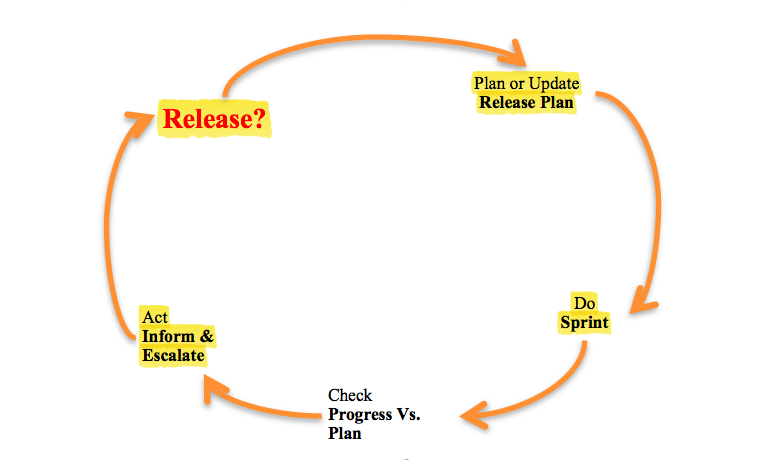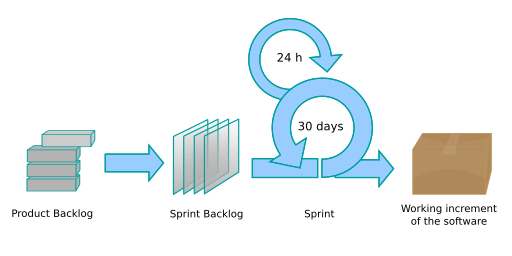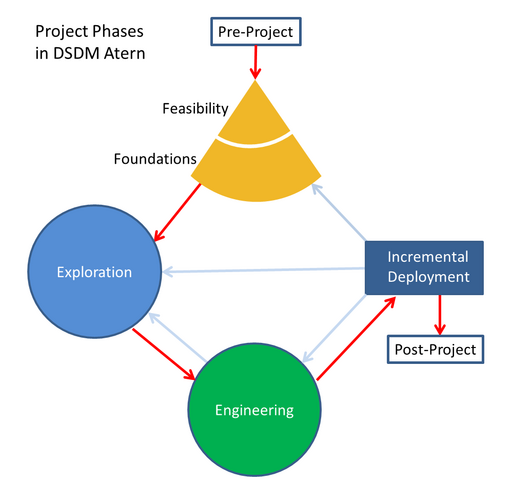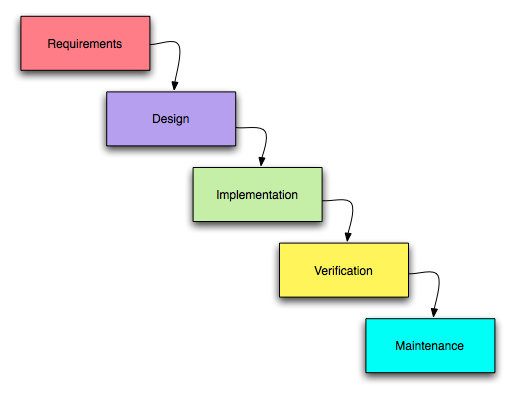Frustrated by ever-changing client requirements and tight project deadlines? You are not alone!
In fact, 94% of global firms1 today adopt Agile as a software development methodology to handle these difficulties. Agile project management takes a flexible and iterative strategy that prioritizes collaboration, client happiness, and continual progress.
This tutorial will look at Agile’s basic ideas and practices, highlighting their importance and relevance in today’s project management world. Interestingly, 98% of organizations report higher success after implementing Agile practices2.
Understanding the benefits of Agile Project Management is critical for anyone looking to improve efficiency, increase customer happiness, or cultivate a more dynamic team environment.
Join us as we uncover how Agile transforms project outcomes and moves your team ahead.
What Is Agile Project Management?
APM is a rigorous project management methodology that emphasizes incremental progress, adaptation, and teamwork.
APM is built on the Agile Manifesto principles and prioritizes small, incremental improvements over large, monolithic project completions. It prioritizes:
- Flexibility: To Respond to changing requirements and feedback throughout the project’s lifecycle
- Collaboration: To encourage open communication and teamwork.
- Customer Satisfaction: To regularly communicate with customers to ensure that the product meets their needs and expectations.
APM uses iterative cycles known as Sprints, in which your team can plan, execute, and evaluate work. This cycle provides regular evaluation and realignment to ensure the project satisfies the company’s objectives and client expectations.
Daily stand-up meetings, sprint planning sessions, and retrospectives are vital practices that attempt to build a culture of continuous development.
Agile Principles and Values: 12 guiding principles underpin Agile Project Management, emphasizing customer-centricity, flexibility, and teamwork. These principles advocate for early and continuous value delivery and changing requirements even later in the development process.
The Agile Manifesto3, written in 2001 by a group of 17 software experts, specifies four key ideas that underpin Agile methodologies:
- Individuals and interactions over processes and instruments: emphasizing the importance of communication and teamwork.
- Working software has priority over extensive documentation: We are committed to providing effective products that satisfy the needs of our clients.
- Customer collaboration above contract negotiation: Developing a collaborative relationship between developers and clients to create alignment.
- Responding to change rather than sticking to a plan: Providing flexibility and adaptability to accommodate changes in project requirements.
What is Agile Methodology?
Agile methodology is a dynamic and iterative approach to project management that promotes security and confidence by emphasizing flexibility, continuous improvement, and quick response to change.
Unlike traditional approaches, Agile divides projects into short, manageable chunks known as Sprints, which run 2-4 weeks. This enables teams to regularly examine project direction and adjust to feedback and changing requirements.
Key Features of Agile Methodology
Iterative Development: Agile development is the process of producing projects in small, incremental cycles. Each iteration builds on the preceding one, refining and improving the project until the end result is accomplished.
Collaborative Approach: Agile encourages frequent collaboration between team members and stakeholders. This continual discussion ensures that everyone is on the same page and that any difficulties are resolved immediately. Leveraging advanced tools, such as generative AI, can further enhance this collaboration by providing real-time data analysis and predictive insights, as discussed in our ultimate guide to Generative AI for Project Managers.
Customer-Centric: Agile promotes customer satisfaction by providing early functional components and soliciting customer feedback throughout development.
How Does Agile Project Management (APM) Work?
Agile Project Management (APM) is an iterative, dynamic method that prioritizes adaptability, teamwork, and client satisfaction. Its fundamental strength is its capacity to provide incremental value throughout a project and quickly adjust to shifting requirements.
This is how APM operates:
Iterative Cycles (Sprints)

- Projects are split into two- to four-week spans known as iterative cycles or sprints.
- Every sprint consists of phases of planning, running, and review.
- This iterative approach guarantees ongoing development by including stakeholder comments and altering criteria.
User Stories and Backlog Management
- Manageable chunks known as user stories help to explain end-user perspective features of projects.
- In a product backlog, stories are ranked so that the most critical and valuable aspects are first developed.
- The team chooses which high-priority stories to focus on going through sprint planning.
Daily Stand-Up Meetings
- Teams have regular stand-up meetings to advance communication and ensure everyone agrees.
- Team members review development, share updates, identify obstacles, and plan activities.
- This mechanism guarantees alignment and solves any issues right away.
Sprint Reviews and Retrospectives

- Following every sprint, a sprint review is conducted to show the completed product to pertinent parties and get comments.
- Feedback guarantees the project remains aligned with client expectations and enables required changes.
- After the sprint review, a retroactive conference evaluates the sprint, addresses areas for development, and suggests areas for expansion.
- The Agile approach is based mostly on constant development.
After each sprint, retrospectives allow teams to reflect on what went well and what can be improved. Read our latest article on effective examples team dynamics to make these reviews even more effective, ensuring that the team collaborates and grows after every cycle
Collaborative Tools and Approaches
- APM makes use of several instruments and techniques to improve cooperation and openness.
- Digital project management tools (like Mirorim), Scrum boards, and Kanban boards for task management, progress tracking, and work visualizations abound here.
- These systems enable teams to remain orderly and deliverable-oriented.
Customer-Centric Approach
- APM puts working with consumers first above contract negotiations.
- Agile teams include clients in development to guarantee the final result satisfies their needs and expectations.
- This tight cooperation helps one react to changes and produces a good that gives value to consumers.
Flexible and Adaptive Planning
- APM welcomes flexibility, unlike conventional project management, which depends on rigid planning.
- Every sprint’s results help the project plan to be routinely refined.
- Adaptive planning guarantees the project’s ongoing relevance and value by allowing teams to react quickly to changes and fresh knowledge.
History of Agile Project Management
Agile Project Management’s history4 is one invention born of need, fundamentally changing how projects are carried out and controlled. This method started in the early 1990s when the software development sector started looking for substitutes for conventional, inflexible project management systems. In fact, it emerged from the necessity for more adaptable, flexible methods.
Software development in the 1990s was plagued by delays, budget overruns, and projects that failed to satisfy user needs. These difficulties inspired a group of forward-looking developers to investigate more cooperative and iterative techniques.
The groundwork for what would become Agile came from influential early approaches such as Scrum, created by Jeff Sutherland and Ken Schwaber, and Extreme Programming (XP), introduced by Kent Beck.

These approaches stressed iterative cycles, constant feedback, and adaptability so that teams would react quickly to shifting needs and customer comments.
The Agile Manifesto and Its Effects
February 2001 was the turning point in Agile techniques’ development. Frustrated with the shortcomings of conventional project management, seventeen software programmers gathered at The Lodge at Snowbird Ski Resort in Utah.
This conference produced the Agile Manifesto, a brief statement of four basic ideals and twelve ideas to enhance software development methods.
Agile Manifesto Focuses on
- Emphasizing the need for human-centric cooperation, individuals and interactions across instruments and procedures should be given priority.
- Functional software delivery comes first while working over extensive documentation.
- Encouragement of continuous client involvement over contract negotiations helps to strengthen bonds.
- Reacting to change instead of following a strategy to welcome adaptation and flexibility.
The Agile Manifesto significantly influenced and started a worldwide movement toward more effective and flexible project management methods. It resulted in the broad acceptance of several Agile frameworks, including Lean, Scrum, Kanban, and others, each helping Agile approaches develop.
As businesses outside of software development saw Agile’s adaptable and iterative advantages, Agile approaches kept developing. Agile Project Management is proven to be ubiquitous in application and of enduring importance today as Agile ideas are used in manufacturing, marketing, and healthcare, among other fields.
The Core Values and Principles of Agile
The Agile methodology is grounded in four core values, each underpinning the Agile approach to project management and development. These values, outlined in the Agile Manifesto, provide a framework for teams to create efficient, responsive, and customer-focused processes.
1. People and Interactions over Tools and Methodologies

- Agile underlines that the main drivers of project success are individuals and their relationships.
- Although tools and procedures are necessary, they should not replace good communication and teamwork; instead, they should complement them.
- Emphasize creating strong, cohesive teams in which open communication and mutual trust rule.
- Give face-to-face meetings and consistent communication a priority to address issues and inspire creativity.
2. Working Software Over Comprehensive Documentation

- Agile emphasizes regularly producing functioning software and prefers shorter development cycles over extensive documentation.
- Instead of generating copious, maybe out-of-date documentation, the focus is on developing software that performs and satisfies user needs.
- Guarantees that stakeholders get real development and may offer comments early and often.
- Keep only necessary records to enable development and application, simplifying the process and allowing one to concentrate on developing worthwhile software.
3. Customer Collaboration Over Contract Negotiation
- Agile supports ongoing customer cooperation to match the project to changing needs and expectations during contract negotiations.
- Agile teams involve customers all through the development process instead of rigidly following first contracts or specifications.
- Get client comments and make changes as needed.
- Encourage a collaborative approach in which consumer comments help shape the final product, improve satisfaction, and guarantee actual value.
4. Reacting to Change Against a Strategy
- Two fundamental Agile values are flexibility and adaptability.
- Acknowledge that change is unavoidable and inspire groups to be receptive to modifying their strategies when fresh data surfaces.
- Unlike conventional project management methods that give strict adherence to plans first priority,
- Accept change as a chance for development to ensure the project stays relevant and in line with stakeholders’ needs.
- Enables iterative methodologies of constant improvement and enhancement of the product
12 Agile Project Management Principles
Derived from the Agile Manifesto, the twelve Agile Project Management principles guide Agile methods. These ideas stress adaptability, teamwork, and ongoing development to make sure teams are effective and value-adding. The twelve ideas are:
- Early and continuous delivery of useful software will help to satisfy clients. Regular releases let one get timely comments and corrections.
- Welcome Changing Needs. Agile methods use change to further the client’s competitive advantage. Flexibility to address changing needs guarantees the final product satisfies even late in development.
- Provide working software regularly. Frequent, incremental delivery of working software, usually in weeks instead of months, guarantees regular progress and constant feedback.
- Close, daily cooperation between business people and developers guarantees alignment and fast problem resolution, promoting a common knowledge of the project objectives.
- Design projects around motivated people. Create the surroundings, provide the required tools, and trust team members to finish the task. Teams that are driven and empowered are more creative and efficient.
- Face-to-face conversations are the quickest and most effective way to transmit knowledge within a development team. They help to reduce misunderstandings and encourage clarity.
- Working software and the provision of functioning programs are the main indicators of development. This idea stresses real outcomes above copious amounts of evidence.
- Agile processes support sustainable development. Teams should keep a continuous speed without stopping to guarantee long-term output free from burnout.
- Improvement of agility calls for constant attention to technical excellence and smart design. Excellent coding and careful architecture simplify software modification and extension.
- Simplicity: Essential is simplicity—optimizing the quantity of work not done. Emphasize offering just what is required, hence minimizing pointless complexity and features.
- Self-organizing teams produce the finest designs, requirements, and layouts. Let teams decide and encourage ownership and creativity.
- The team considers how to become more effective at regular intervals, then tunes and modifies its behavior. Long-term success requires constant improvement.
Benefits of Agile Project Management
More Adaptability (and Less Risk)

- Agile techniques stress iterative development and flexibility, hence reducing risk.
- Teams can react fast to unanticipated problems and shifting needs.
- Using constant modifications and upgrades, this flexibility lowers project risk.
- For instance, using Agile, a software development company reduced risks and changed its approach depending on market needs and customer comments.
Greater Customer Satisfaction
- Agile emphasizes client cooperation and iterative delivery to raise satisfaction.
- Guarantees the end result closely fits consumer expectations and requirements.
- Including clients all through the project lets you get quick comments and changes.
- For instance, Agile helped a healthcare IT company create a patient management system. Regular customer reviews and comments raised patient satisfaction and operational effectiveness.
Happier Teams
- Agile helps to create a cooperative and encouraging workplace.
- Team members know exactly their roles and duties.
- Frequent stand-up meetings, sprint reviews, and retrospectives support candid dialogue and ongoing development.
- For instance, a marketing business claimed a 20% rise in employee satisfaction ratings following Agile’s adoption, clarifying the change to improved teamwork and more defined project goals.
Increased Project Control
- Through regular monitoring and assessment, agile gives project managers more control.
- Effective task and deadline tracking for teams depends on tools like Scrum and Kanban boards.
- More visibility lets one spot problems early on and fix them.
- For instance, better tracking and timely Agile interventions helped a manufacturing company observe a 30% drop in project delays.
Boosted Collaboration
- Agile stresses constant communication and team building.
- By use of common goals, cross-functional teams break down silos and promote knowledge sharing.
- For instance, after using Agile, a financial services organization saw a 25% rise in project completion rates; this achievement is credited to better inter-departmental coordination.
Speed to Market
- The iterative technique of Agile speeds up the development process.
- It starts with delivering top-priority features first, therefore facilitating faster market introductions.
- For instance, using Agile approaches, a software startup shortened its 12-month product release cycle to 6 months, acquiring a competitive edge in the tech scene.
Detailed Agile Methodologies
Agile Project Management consists of several models, each suited for certain project requirements and organizational settings. The most well-known Agile frameworks are broken out in-depth here:
Scrum

- Among the most often used Agile frameworks, Scrum is well-known for its simplicity and efficiency in handling challenging initiatives. It is set up around small, cross-functional teams working in sprints—usually two to four-week time-boxed iterations. Important elements of the Scrum system consist in:
- Teams decide on topics from the product backlog to focus on and specify their sprint target.
- Short daily meetings called “stand-ups” allow team members to go over daily plans, challenges, and advancements.
- After every sprint, the team shows the finished work to interested parties for comments.
- Teams examine their sprint to find areas that may be improved for the next runs.
Read More: Scrum Project Management ✅ Guide for +800% Productivity
Kanban Method

Kanban Project Management is a visual tool stressing efficiency and constant delivery. It tracks progress, shows work items on a Kanban board, and points up areas of congestion. Important Kanban method concepts include:
- Showing all activities on a Kanban board will help to give openness and visibility.
- Work in Progress (WIP) Limitations to minimize the number of jobs under development will help avoid team overload.
- Releasing work items straight away upon completion instead of in set batches is known as constant delivery.
Lean Product Development in Software
Lean Software Development emphasizes offering value to consumers and streamlining efficiency through waste elimination and quality enhancement, inspired by Lean manufacturing ideas. It modifies them to fit software development. Important lean software development techniques consist in:
- Eliminating waste: spotting and getting rid of activities the client finds useless.
- Including quality assurance techniques throughout the development process helps to build integrity
- Reducing cycle times helps one rapidly and effectively deliver value.
Dynamic Systems Development Method (DSDM)

DSDM is an Agile methodology stressing the whole project lifecycle from feasibility to post-project evaluation. It offers a complete project management method with an eye toward producing commercial value. Essential components of DSDM are:
- Timeboxing—allocating certain project phase durations—allows for timely completion.
- MoSCoW Prioritizing: Must have, should have, could have, won’t have a classification for needs.
- Regular stakeholder comments enable iterative development of solutions, small by increments.
Disciplined Agile Delivery (DAD)
DAD is a process decision framework designed to help companies select the best suitable Agile techniques for their situation. It brings Scrum’s complete delivery lifetime within its purview. Important elements of DAD consist of:
- Finding objectives at every project stage and choosing methods to reach them are process goals.
- Making sure Agile methods fit company objectives and constraints guarantees enterprise awareness.
- Agile governance is the balancing act between adequate control and self-organization.
Feature-Driven Development (FDD)
Designed and built features define FDD, an Agile methodology. Larger projects needing thorough planning and tracking will find it especially appropriate. Important FDD activities consist of:
- Establishing an overall picture of the system architecture helps one to develop a high-level vision.
- Creating feature lists helps one to recognize and rank the aspects to be developed.
- Create cross-functional teams to advance particular skills.
Extreme Programming (XP)
Extreme Programming (XP) is an Agile method emphasizing technical excellence and regular releases. It advances pair programming, test-driven development (TDD), and continuous integration. XP has key practices, including:
- Two developers pair programming to raise the caliber of code on one workstation.
- Writing tests before code guarantees functionality and helps to lower errors.
- Often integrating and testing code helps to identify problems early on.
Read More: Who Should Project Manager Interact With When Doing Integration Process?
Adaptive Software Development (ASD)
Based on Agile methodology, Adaptive Software Development (ASD) emphasizes learning and change adaptation through a project. It stresses flexibility, education, and teamwork. Important ASD principles include:
- Plan and hypothesize regarding the future course of the project.
- Working closely with stakeholders helps to improve and change the project plan.
- Learn: Always developing depending on comments and fresh knowledge.
Agile vs. Other Methodologies
Agile vs. Scrum

Agile is a general philosophy that covers several approaches, including Scrum. It stresses adaptation, teamwork, client happiness, and ongoing development. Agile approaches are adaptable and iterative and emphasize delivering value through small, gradual changes.
Scrum is a particular Agile framework underlined within the Agile umbrella. With clear roles (Scrum Master, Product Owner, and Development Team) and ceremonies (Sprint Planning, Daily Stand-ups, Sprint Reviews, and Retrospection), it is quite regimented. Usually lasting two to four weeks, Scrum’s time-boxed iterations—known as sprints—also
Key Differences:
- Agile is a general philosophy; Scrum is a particular toolkit.
- Agile can be carried out without these exact guidelines; Scrum has well-defined roles and organized ceremonies.
Agile vs. Kanban
Kanban is another framework within the Agile philosophy, emphasizing visual workflow management and continuous delivery. Unlike Scrum, Kanban does not use time-boxed sprints. Instead, it focuses on limiting work in progress (WIP) and visualizing tasks on a Kanban board to improve efficiency and identify bottlenecks.
Key Differences:
- Workflow Management: Kanban uses WIP limits and visual boards, while Agile spans several workflows, including Kanban.
- Delivery: Kanban stresses ongoing delivery; Agile methods could make use of sprints or other iterative techniques.
Agile vs. Waterfall

One classic project management technique distinguished by a linear, sequential approach is waterfall development. With little space for revisions once one phase is completed, each—requirements, design, implementation, verification, and maintenance—must be finished before turning to the next. This stands quite the opposite from Agile’s adaptability.
By contrast, Agile approaches prioritize flexibility and responsiveness. Small increments with regular feedback loops help break out projects so that teams may change according to stakeholder comments and changing needs.
Key Differences:
- Agile lets one make changes and adjustments; Waterfall flows strictly and linearly.
- Agile runs iterative cycles; Waterfall is sequential and phase-based.
- Agile lowers risk through constant feedback; Waterfall can be riskier because of its inflexibility and late-stage testing.
Read More: Waterfall Project Management ✅ All You MUST Know
Real-World Examples of APM
Agile Project Management (APM) has proven transformative across various industries. Here are detailed case studies showcasing the success of Agile methodologies in different sectors.
Spotify’s Agile Transformation
Challenge: Spotify5, the leading music streaming platform, battled siloed teams, slow release schedules, and a lack of customer emphasis.
Agile Solution: In 2012, Spotify embraced a modified Scrum structure using cross-functional teams to spur creativity and improve cooperation. Regular feedback sessions and iterative development—two agile techniques—were applied.
Impact:
- Productivity: Much was raised as teams collaborated more harmonically.
- Employee satisfaction: rises from improved teamwork and well-defined project objectives.
- Time-to-Market: Minimized, enabling faster reactions to changes in the market and ongoing user feedback integration
John Deere’s Global IT Agile Transformation

Challenge: John Deere John Deere 6had to modernize its technology stack, increase operational effectiveness, and cut project delivery times.
Agile Solutions: Along with technical upskills and DevOps integration, John Deere embraced Scrum and Scrum@Scale models.
Impact:
- 125% more output
- Time-to-market dropped by 40%
- Employee NPS (eNPS) increased by 20 points.
- Labor costs dropped by 20%, showing a notable cost economy. This complete Agile transformation included Agile into their main business plan by aligning the company around Agile value streams.
Insurance Company’s Agile Adoption
Challenge: Insurance Companies7 suffered from inflexibility and long project cycles.
Agile Solution: After securing executive sponsorship, offering thorough training, and building cross-functional teams, I switched to Agile.
Impact:
- 20% less cycle time.
- Close to $5 million in savings
- Team performance has improved dramatically, which raises client happiness. This change showed how well Agile might enhance flexibility in the financial services industry and streamline procedures.
Intel’s Engineering Development with Scrum
Challenge: Intel had to simplify8 its engineering development process and raise team cooperation.
Solution: Scrum was used in three phases: preparation, conquering first obstacles, and improving cross-functional team cooperation.
Impact:
- 66% less Cycle Times
- Two-week sprint cadence helps one to schedule adherence.
- Improved communication and well-defined project objectives raise employee satisfaction. Intel’s success with Scrum underlined how well the approach might increase efficiency and simplify technological industry engineering procedures.
BBC’s New Media Division with Scrum
Challenge: BBC’s media division9 needed a more flexible project management strategy because it experienced great uncertainty and was developing processes.
Solution: Using the Scrum framework, created cross-disciplinary teams, and gave thorough Scrum Master training.
Result:
- Productivity: Better team cooperation and methodologies of structured work helped to greatly increase it.
- Improved capacity to react fast to evolving needs.
- Constant improvement is encouraged via frequent retrospectives and feedback loops. This Agile transition proved the effectiveness of Agile techniques in the media sector, enabling quicker and more effective project delivery.
How to Become Agile
Turning to Agile Project Management will help your team be much more flexible, productive, and generally successful. Here are doable actions your company can take to adopt Agile:
Putting the Correct People on Board
Select Agile Champions: Find and enlist people driven by Agile ideas who can act as your company’s change agents. These Agile leaders will motivate others to welcome the change and help Agile techniques to be adopted.
Train Current Team Members: Give your present team members thorough training. Seminars, workshops, and agile boot camps help you grasp Agile values, ideas, and methods. Stress the need for positions such as Agile Coach, Product Owner, and Scrum Master to promote a cooperative and effective workplace.
Foster a Collaborative Culture: Encourage team members to open communication, transparency, and constant feedback to help foster a collaborative culture. Successful Agile deployment depends on a culture that celebrates mutual respect and teamwork.
Getting Agile Certification
This helps to confirm your knowledge of Agile approaches. Popular certificates include:
- Ideal for those wishing to oversee Scrum teams, Certified Scrum Masters (CSM)
- Focuses on using Agile ideas in project management as a certified Agile Project Manager (IAPM).
- SAFe Agilist (SA) for those in more prominent companies needing Agile application methods.
Using the Right Tools
- Select the ideal Agile tools to simplify your Agile procedures. Perfect for Agile teams, Mirorim is a great tool for managing projects that combines productivity and self-care aspects. Mirorim gives:
- Real-time chats and task assignments help team members to communicate smoothly and distribute work among them.
- File sharing and teamwork make documents readily shared and make cooperative work possible.
- Emotional insights provide an understanding of team members’ emotional states, enhancing self-awareness and personal development.
- Review often and adjust regularly. Agile’s core is always an improvement. Review your tools and procedures often to ensure they satisfy your team’s demands. Be receptive to using fresh tools to enhance your Agile methods.
Step-by-Step Guide to Implementing Agile
Turning to Agile Project Management will transform your team’s approach to project management and improve flexibility, cooperation, and output. This is a practical, methodical guide to enable you to apply Agile successfully:
Envision
Clearly stating your project vision and goals will help you to start the Agile change. This is determining how Agile’s goals fit your general company objectives and what you hope to accomplish using it. Over the Agile process, a clear vision will direct your team and partners.
- Involve participants to grasp their expectations and needs.
- Write a strong vision statement explaining the objectives and reasons behind using Agile.
- Clearly state goals to monitor advancement and success
Speculate
Plan the Agile Transition: Here, you hypothesize and map out your path to Agile. This involves choosing the suitable Agile framework—Scrum, Kanban, etc.—determining team roles and developing the project road map.
- Select an Agile framework best for your project and organizational requirements.
- Describe positions including Agile Coach, Product Owner, and Scrum Master.
- Create a high-level road map including important deliverables and benchmarks.
Explore
Start using Agile methods by running your first sprints or iterations. This stage is about investigating and using Agile methods to determine which best suits your team.
- Test Agile techniques and get comments starting with a pilot project.
- Plan daily stand-ups, run retrospectives, and create sprints.
- Promote among team members honest communication and cooperation.
Adapt
Based on feedback and observations, refine and improve your Agile methods to better satisfy your team’s needs and those of your customers. Agile approaches are built mostly on constant improvement.
- Review sprint results often to find places that need work.
- Team comments and performance data will guide changes to tools, procedures, and practices.
- Encourage an always learning and flexible culture.
Close
Consider the successes and difficulties of each project phase or iteration to close the cycle. This stage guarantees that acquired knowledge is recorded and implemented in the next initiatives.
- Have a last retro to go over areas for development and success.
- Share with the larger company your best practices and lessons discovered.
- Honor team accomplishments as well as individual efforts.
- Following these guidelines—envision, speculate, investigate, adapt, and close—you can control the shift to Agile and handle typical Agile difficulties.
Include checklists or templates that can be downloaded, adding value and engagement.
Common Challenges of Agile Project Management +Solutions
Agile Project Management is a great method that supports flexibility and cooperation even if it has specific challenges. Here is how you use genuine case studies and pragmatic solutions to tackle common Agile challenges:
Meeting Changing Needs
Agile’s flexibility allows one to satisfy changing needs; nevertheless, continual adjustments might hinder growth and cause team members confusion.
Your solution will be a robust change management system. Usually, rank and review backlog items during haul planning meetings. Regular involvement of stakeholders guarantees the correct application of modifications and communication with them.
John Deere, for instance, used Agile concepts to quickly adjust to evolving market needs.They reduce time-to-market by 40% and increase output by 125% by implementing Scrum and Scrum@Scale.
Handling Scope Creep
Challenge: Scope creep—that is, when the project’s scope grows outside of the first plans—may compromise finances and deadlines.
Solution: Clear project boundaries and apply the MoSCoW prioritizing approach (Must have, Should have, Could have, Won’t have) to control features.
By using a product backlog to postpone lower-priority changes to the next sprints and enforcing rigorous sprint targets, a financial services company addressed scope creep. This method kept one focused and produced important features on schedule.
Read More: How To Define Boundaries In a Project ⛔
Managing Team Dynamics
Challenge: Effective team collaboration and dynamics are crucial for Agile success. Misalignment or conflicts within the team can hinder productivity.
Solution: Foster an open and collaborative culture. Regular team-building activities and open communication channels enhance trust and cooperation.
For example, Penta Technologies used Agile10 to transition from a siloed environment to one with greater agility, significantly improving team collaboration and overall productivity.
Read More: Good Icebreaker Questions for Team Collaboration (Chosen by Top Experts) ✅
Effective Time Management
Challenge: Agile success depends on efficient team dynamics and cooperation, so challenges exist. Conflicts or misalignment inside the team could lower output.
Solution: Encourage a transparent and cooperative culture. Frequent team-building exercises and open contact lines help establish trust and harmony.
Penta Technologies, for instance, applied Agile to move from a siloed environment to one with more adaptability, greatly enhancing team cooperation and general output.
Overcoming Lack of Metrics
Challenge: Measuring performance and advancement in Agile might be difficult given the iterative and flexible method used there.
Solution: Agile measures, including velocity, burndown charts, and cumulative flow diagrams, will help you understand team performance. Review these indicators often throughout sprint retrospectives to find areas needing work.
Focusing on iterative development and continuous learning, Intel employed Scrum11 to better the execution of its projects, hence enhancing performance tracking and general productivity.
Expert Tips and Best Practices of APM
Transitioning to Agile Project Management (APM) can revolutionize your project outcomes. Here are expert tips and best practices sourced from experienced Agile practitioners to help you maximize the benefits of APM.
Advice from Experienced Agile Practitioners
Embrace a Mindset of Continuous Improvement: “Agile is not just a methodology, but a mindset,” says Jeff Sutherland, co-creator of Scrum.
He emphasizes the importance of continuous improvement and adaptability as core elements of Agile. He always seeks feedback and uses retrospectives to enhance team performance.
Prioritize People and Communication: Agile expert Mike Cohn advises, “Focus on individuals and interactions over processes and tools.”
This principle, rooted in the Agile Manifesto, highlights the importance of fostering strong team dynamics and open communication to drive project success.
How to Choose the Best Agile Project Management Software
Evaluate Based on Team Needs: When selecting Agile software, consider your team’s specific needs. Tools like Mirorim and Azure DevOps offer a range of features to support Agile workflows.
“The best Agile tools align with your team’s processes and enhance collaboration,” says Agile coach Lyssa Adkins.
Look for Integration Capabilities: Ensure the software integrates well with other tools your team uses. Seamless integration can streamline workflows and improve efficiency. For example, Mirorim integrates with various productivity tools, making it a versatile choice for Agile teams.
Remote Team Support
Leverage Digital Communication Tools: Effective remote team support hinges on robust communication tools. Platforms like Slack, Zoom, and Microsoft Teams facilitate real-time communication and collaboration.
“Regular virtual stand-ups and check-ins are crucial for maintaining team cohesion and alignment,” suggests Agile practitioner Henrik Kniberg.
Implement Clear Communication Protocols: Establish clear communication protocols to ensure everyone stays informed and engaged. Defining the frequency and channels for updates, meetings, and feedback sessions.
Backlog Planning and Management
Use Prioritization Techniques: To manage your backlog effectively, employ prioritization techniques like MoSCoW (Must have, Should have, Could have, Won’t have).
“A well-groomed backlog is the backbone of a successful Agile project,” notes Roman Pichler, an Agile product management expert.
Regular Backlog Refinement: Conduct regular backlog refinement to keep the backlog up-to-date. This ensures that the highest-priority items are always ready for the next sprint.
Progress Tracking
Visualize Work with Agile Metrics: Track progress using Agile metrics such as burndown charts, velocity, and cumulative flow diagrams.
“Visualizing work helps teams stay on track and identify bottlenecks early,” says Agile coach.
Frequent Reviews and Adjustments: Regularly review progress against sprint goals and adjust. This allows your team to stay agile and responsive to changes.
Collaboration Features
Foster a Collaborative Culture: Collaboration tools like Mirorim provide features that support teamwork and transparency.
“Collaboration is the heart of Agile; tools that enhance visibility and communication are invaluable,” says Agile thought leader Jim Highsmith.
Encourage Peer Reviews: Implement peer reviews to enhance quality and share knowledge within the team. This not only improves deliverables but also fosters a learning environment.
Workflows for Review and Approval
Define Clear Approval Processes: Establish clear workflows for review and approval to ensure accountability and quality.
“Having a well-defined review process helps maintain high standards and keeps the project on track,” advises Agile consultant Alistair Cockburn.
Automate Where Possible: Use automation tools to streamline repetitive tasks in the review and approval process. This saves time and reduces errors for you to focus on value-added activities.
Glossary of Agile Terminology
| Term | Definition |
| Agile | An iterative approach to project management and software development that emphasizes flexibility, collaboration, customer satisfaction, and continuous improvement. Agile methodologies prioritize delivering small, incremental changes. |
| Scrum | A specific Agile framework used for developing, delivering, and sustaining complex products. Scrum employs time-boxed iterations called sprints, typically lasting two to four weeks. Key roles include Scrum Master, Product Owner, and Development Team. |
| Kanban | A visual workflow management method within the Agile family that focuses on continuous delivery and efficiency. Kanban uses a board to visualize work items, track progress, and identify bottlenecks. Unlike Scrum, it does not use time-boxed iterations. |
| Sprint | A time-boxed period, usually lasting between one to four weeks, during which a specific set of work must be completed and made ready for review. Sprints are fundamental to the Scrum framework, promoting regular progress and continuous feedback. |
| Product Backlog | A prioritized list of work for the development team, managed by the Product Owner. The backlog includes user stories, bug fixes, features, and enhancements that need to be addressed in future sprints. |
| User Story | A concise, simple description of a feature or functionality from the perspective of the end user. User stories are typically written in the format: “As a [user], I want [function] so that [benefit].” |
| Burndown Chart | A graphical representation of work left to do versus time. It is used to track the progress of a sprint, helping teams monitor their velocity and stay on track to complete tasks by the end of the sprint. |
| Velocity | A measure of the amount of work a team can complete during a single sprint, typically measured in story points. Velocity helps in forecasting the amount of work a team can handle in future sprints. |
| Retrospective | A meeting held at the end of each sprint where the team reflects on the sprint’s successes and failures. The goal is to identify areas for improvement and actionable steps to enhance future sprints. |
| MoSCoW Prioritization | A method used to prioritize tasks into four categories: Must have, Should have, Could have, and Won’t have. This technique helps manage scope and ensure critical features are delivered on time. |
Conclusion
Agile Project Management is the key to success in today’s dynamic, fast-paced environments. It’s all about adaptability, collaboration, and steady improvement. Agile prepares your team for success, regardless of the complexity or unpredictability.
Here are the main takeaways from our blog.
- Stay Flexible: Agile allows you to easily adapt to changes, ensuring that your project remains relevant and meets evolving stakeholder needs.
- Iterative Development: Breaking down projects into smaller sprints allows for regular assessment and realignment, promoting continuous improvement.
- Improve Collaboration: Ongoing collaboration between business stakeholders and developers ensures that everyone is on the same page and that issues are resolved quickly.
- Keep Customers Satisfied: Delivering valuable software early and often allows you to incorporate feedback quickly and keep your customers satisfied.
- Motivate Your Team: Empowering your team and providing appropriate support increases productivity and innovation.
- Focus on Quality: Consistently prioritizing technical excellence and good design makes your software easier to modify and extend.
- Simplify: Prioritizing important features and avoiding unnecessary complexity leads to efficient, high-value work.
- Empower Teams: Self-organizing teams make better decisions and take ownership, resulting in superior project outcomes.
- Reflect and Adjust: Conducting regular retrospectives allows your team to identify areas for improvement and fine-tune their practices for greater efficiency.
Now is the ideal time to embrace Agile. To get started, create a Free account on Mirorim, a powerful project management tool that can automate communication, task management, and progress tracking.
Why wait? Begin your Agile journey with a free signup on Mirorim today. Experience the flexibility, collaboration, and continuous improvement that Agile provides.
FAQs | Agile Project Management
No, Agile Project Management goes beyond software development. Although its roots are in the software sector, Agile ideas apply in many fields, including marketing, healthcare, education, and manufacturing.
Because of its adaptability and emphasis on iterative development and teamwork, Agile is ideal for every project that benefits from flexibility and constant improvement.
Agile Project Management presents common difficulties in managing changing needs, controlling scope creep, preserving team relationships, efficient time management, and progress measurement.
Dealing with these issues calls for strong change management systems, well-defined priorities, a cooperative culture, disciplined time management, and careful use of performance tracking indicators.
Teams and companies that must react quickly to change, give customer input top priority, and provide little value throughout the project life find Agile most suited. It is especially successful in dynamic settings where needs will probably change and cooperation and ongoing development are crucial.
Agile might not be appropriate for projects with extremely steady and predictable needs, tight regulatory constraints, or environments needing thorough advance preparation and documentation. Conventional project management techniques, including Waterfall, could be more suitable in such situations.
Yes, Agile can be combined with other approaches. Known as a hybrid methodology, this technique lets teams take advantage of Agile’s adaptability while including components of conventional approaches, such as Waterfall, for structure and planning. Many companies effectively apply hybrid models to fit their project management strategy to particular requirements.
Agile Project Management is iterative planning, constant collaboration, integration of client feedback, and flexibility to fit evolving needs. Aiming to provide little value at once and encourage ongoing development, key techniques include sprint planning, daily stand-ups, sprint reviews, and retrospectives.
Agile is a project management approach that emphasizes iterative development, teamwork, and adaptability. Agile and conventional approaches are among the several techniques in the credential PMP (Project Management Professional). Those with PMP certificates have the tools to oversee projects utilizing Agile, among other methods.
Agile project management consists of six steps: envision, speculate, explore, adapt, close, and transition. From the first vision through iterative development and constant improvement to the final delivery and transition, these actions direct the project.
The PMP certification also covers Agile and Waterfall approaches. It provides project managers with a thorough awareness of many project management techniques, enabling them to select the most appropriate one for their particular project.
Agile is a more general concept covering several approaches, including Scrum. Scrum is a particular Agile framework with well-defined roles and rituals. Neither is intrinsically better; the decision relies on the team’s tastes and project criteria.
Yes, Agile Project Management is worth it for initiatives that benefit from adaptability, incremental improvement, and constant feedback. It can also lead to faster delivery, more client happiness, and better team cooperation.
Although both certifications provide useful abilities, their fit for different professional paths depends on While Scrum Master concentrates on Agile Scrum methods, PMP covers many project management approaches. Use PMP for a general approach; for a specialist Agile concentration, use Scrum Master.
Gantt charts are usually associated with waterfall project management because they are linear and sequential. However, they can be modified to show timeframes and dependencies for use in Agile projects.
Reflecting the rising relevance of Agile principles in project management, about 50% of the PMP test content is on Agile and hybrid approaches.
The main idea is Agile, and Scrum is a particular Agile framework. Knowing Agile ideas helps you apply Scrum methods.
Yes, Agile approaches—especially Scrum—use sprints. Usually spanning 1 to 4 weeks, sprints are time-boxed repetitions of a particular set of work.
Agile is a flexible and iterative method of project management and software development that focuses on delivering modest, incremental improvements via ongoing collaboration and feedback.
Although experience and geography affect salaries, generally, PMP-certified professionals have more earning potential because of the larger range of the certification. Especially in Agile-centric companies, Scrum Masters also demand competitive pay.
Although PMOs may earn more because of their wider responsibility in supervising project management across an entity, Scrum Masters and PMOs have similar incomes.
If you wish to focus on Agile Scrum practices, choose Certified Scrum Master (CSM). If you want a thorough certification covering many project management approaches, including Agile, go for PMP.
Welcoming flexibility, constant integration, and delivery, Microsoft mostly applies Agile approaches to its software development initiatives.
Yes, Agile can be used without sprints using frameworks like Kanban, which stresses continuous flow above time-boxed iterations.
In Agile, a normal sprint lasts one to four weeks, with two weeks being the most common length.
The Scrum Master, Product Owner, and Development Team collaborate on Sprint planning. Together, they choose backlog items to be finished and determine the sprint target.
References
- Orgs practicing Agile in 2021 | Blog | Digital.ai. (n.d.). Digital.ai. https://digital.ai/catalyst-blog/how-are-organizations-practicing-agile-in-the-year-2021/ ↩︎
- State of Agile. (2016). In VersionOne. https://www.agile247.pl/wp-content/uploads/2017/04/versionone-11th-annual-state-of-agile-report.pdf ↩︎
- A Short History of Agile | Agile Alliance. (2024b, June 25). Agile Alliance |. https://www.agilealliance.org/a-short-history-of-agile/ ↩︎
- Balaban, S., & Đurašković, J. (2021). Agile project management as an answer to changing environment. European Project Management Journal, 11(1), 12-19. https://doi.org/10.18485/epmj.2021.11.1.2 ↩︎
- Layden, A. (2024, February 16). Spotify: A Scrum@Scale Case Study – Scrum@Scale Framework. Scrum@Scale Framework. https://www.scrumatscale.com/spotify-a-scrumscale-case-study/ ↩︎
- Agile Unleashed at Scale: John Deere Case Study – Scrum Inc.TM. (2022b, June 26). Scrum Inc. https://www.scruminc.com/agile-unleashed-scale-john-deere-case-study/ ↩︎
- Lorenz, J. T., Mahadevan, D., Oncul, B., & Yenigun, M. (2020, September 14). Scaling agility: A new operating model for insurers. McKinsey & Company. https://www.mckinsey.com/industries/financial-services/our-insights/scaling-agility-a-new-operating-model-for-insurers ↩︎
- Elwer, P., Gallagher, T., Playfair, K., Rawsthorne, D., & James, M. (n.d.-b). Agile Project Development at Intel: A Scrum Odyssey. http://www.michaeljames.org/Intel-case-study.pdf ↩︎
- Preuss, D. H. (2006, December 20). InfoQ Presentation: Scrum at the BBC. InfoQ. https://www.infoq.com/news/2006/12/Scrum-bbc-newmedia/ ↩︎
- A Six-Month Cultural Transformation – A Penta Story. (n.d.). Scrum.org. https://www.scrum.org/resources/six-month-cultural-transformation-penta-story ↩︎
- Case Study – Intel – Scaled Agile Framework. (2018, March 19). Scaled Agile Framework. https://v5.scaledagileframework.com/case-study-intel/ ↩︎

